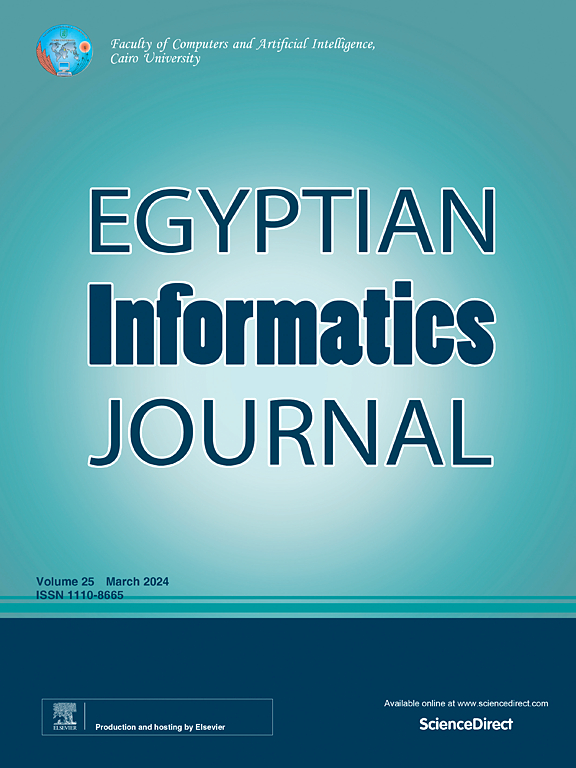Improving data transmission through optimizing blockchain sharding in cloud IoT based healthcare applications
IF 4.3
3区 计算机科学
Q1 COMPUTER SCIENCE, ARTIFICIAL INTELLIGENCE
引用次数: 0
Abstract
The rapid progress of blockchain technology is increasingly crucial in healthcare systems, where Electronic Health Records (EHRs) store vital and confidential information. However, these systems are susceptible to security risks like unauthorized access and data breaches. To tackle these issues, a decentralized, tamper-proof, and transparent healthcare network is necessary. According to this fact, the Sec-Health protocol utilizes cryptographic techniques with blockchain and InterPlanetary File System (IPFS) to safeguard EHRs. Despite advancements, managing large files, such as medical imaging data, remains a challenge due to scalability issues and limited research. Introducing sharding has the potential to improve network scalability, but if not configured correctly, it could result in orphan blocks and forks, leading to security vulnerabilities and network delays. To address this, a new sharded blockchain-based protocol called an Adaptive Sec-Health (AdaSec-Health) is proposed, utilizing an Enhanced Coati Optimization Algorithm (ECOA) in high-throughput and low-latency healthcare systems. The ECOA optimizes multiple factors to minimize orphan blocks and forks while balancing Fork Probability (FP) and User Experience (UE). Also, it introduces a cost function to optimize network security-stability tradeoffs. Thus, AdaSec-Health protocol improves the scalability and security of healthcare blockchain systems. The experiments are conducted on the network EIP-1559 using 1000 nodes with 1 to 4 shards to validate the scalability and security of the AdaSec-Health protocol. The results demonstrate that the AdaSec-Health protocol achieves 3280 transactions per second (tps) of mean throughput, 28 s of mean user-perceived latency, 0.47 gas unit of average marginal cost, 36 transactions of average block size, and a 13-second mean interval between blocks for 1000 nodes in 4 shards compared to the other healthcare blockchain systems. In terms of security analysis, AdaSec-Health achieves 7087 tps, 6738 tps, and 6400 tps for simple attacks, camouflage attacks, and observe-act attacks across 20 epochs.
通过优化基于云物联网的医疗保健应用中的区块链分片来改善数据传输
区块链技术的快速发展在医疗保健系统中越来越重要,电子健康记录(EHRs)存储重要和机密信息。然而,这些系统容易受到未经授权访问和数据泄露等安全风险的影响。为了解决这些问题,一个分散的、防篡改的、透明的医疗保健网络是必要的。根据这一事实,Sec-Health协议利用区块链和星际文件系统(IPFS)的加密技术来保护电子病历。尽管取得了进步,但由于可扩展性问题和有限的研究,管理大型文件(如医学成像数据)仍然是一个挑战。引入分片有可能提高网络的可扩展性,但如果配置不正确,它可能会导致孤立块和分叉,从而导致安全漏洞和网络延迟。为了解决这个问题,提出了一种新的基于分片区块链的协议,称为自适应安全健康(AdaSec-Health),在高吞吐量和低延迟医疗保健系统中利用增强型Coati优化算法(ECOA)。ECOA优化了多个因素,以最大限度地减少孤儿块和分叉,同时平衡分叉概率(FP)和用户体验(UE)。此外,它还引入了一个成本函数来优化网络安全与稳定性的权衡。因此,AdaSec-Health协议提高了医疗保健区块链系统的可扩展性和安全性。在EIP-1559网络上使用1000个节点和1 ~ 4个分片进行实验,验证AdaSec-Health协议的可扩展性和安全性。结果表明,与其他医疗保健区块链系统相比,adasc - health协议的平均吞吐量为每秒3280笔交易,平均用户感知延迟为28秒,平均边际成本为0.47 gas单位,平均块大小为36笔交易,4个分片中1000个节点的块之间平均间隔为13秒。在安全分析方面,AdaSec-Health在20个epoch中对简单攻击、伪装攻击和观察行为攻击分别达到7087 tps、6738 tps和6400 tps。
本文章由计算机程序翻译,如有差异,请以英文原文为准。
求助全文
约1分钟内获得全文
求助全文
来源期刊

Egyptian Informatics Journal
Decision Sciences-Management Science and Operations Research
CiteScore
11.10
自引率
1.90%
发文量
59
审稿时长
110 days
期刊介绍:
The Egyptian Informatics Journal is published by the Faculty of Computers and Artificial Intelligence, Cairo University. This Journal provides a forum for the state-of-the-art research and development in the fields of computing, including computer sciences, information technologies, information systems, operations research and decision support. Innovative and not-previously-published work in subjects covered by the Journal is encouraged to be submitted, whether from academic, research or commercial sources.
 求助内容:
求助内容: 应助结果提醒方式:
应助结果提醒方式:


